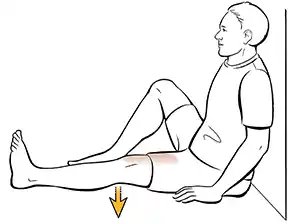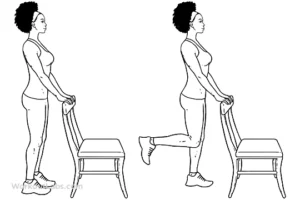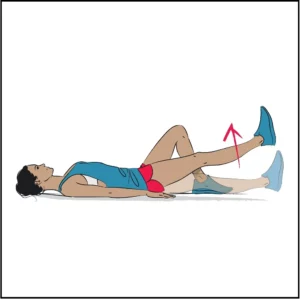A single step upward and there it is again – that sharp or dull ache in your knee. Climbing stairs, a simple daily activity, shouldn’t be a painful challenge, right? Yet, for many, it’s an ordeal they dread each day. You’re not alone in your struggle. Knee pain while ascending stairs is more common than you might think, often hinting at underlying issues. But here’s the silver lining: there are ways to navigate and mitigate this pain. Whether you’re looking for a quick relief trick, an exercise to strengthen your knee, or just a deeper understanding of what’s causing the discomfort, we’ve got your back—or, in this case, your knee. Let’s dive in and explore the journey from recognizing the cause to finding the solution.
Contents
Why Stairs Can Exacerbate Knee Pain?
 Stepping onto a stair might seem like a straightforward motion, but when you break down the mechanics of it, stair climbing is quite a complex activity for your knees. Here’s why this simple act can sometimes send a surge of pain through your knee:
Stepping onto a stair might seem like a straightforward motion, but when you break down the mechanics of it, stair climbing is quite a complex activity for your knees. Here’s why this simple act can sometimes send a surge of pain through your knee:
- Increased Load on the Knee: When you ascend stairs, your knee has to support a significant portion of your body weight, much more than when walking on a flat surface. In fact, climbing stairs can put a force equivalent to three to four times your body weight on the knee joint!
- Knee Flexion Angle: As you step onto a higher platform (like a stair), the knee goes into deeper flexion. The greater this angle, the more stress is placed on certain parts of the knee, especially the patella (kneecap) and its tendon.
- Engagement of Multiple Muscle Groups: Climbing stairs isn’t just about the knees; it also requires coordinated effort from the quadriceps, hamstrings, and calf muscles. If there’s a weakness in any of these groups, the knee may take on additional strain.
- Potential for Compensatory Movements: If you’ve been feeling knee pain for a while, you might unknowingly change your stair-climbing technique to reduce discomfort. These compensatory movements can sometimes put even more stress on the knee or other parts of the body.
- Repetitive Motion: Think about the number of steps you take every day, especially if you live or work in a multi-story building. This repetitive motion, especially under strain, can exacerbate existing knee issues.
- Underlying Knee Conditions: If there’s an existing condition like osteoarthritis, meniscus tears, or patellar tendinitis, the act of climbing stairs can highlight and amplify the discomfort associated with these problems.
In essence, while stairs are a part of our daily routine and a great form of exercise, they can be particularly taxing on a compromised knee.
Common Causes of Knee Pain While Going Up Stairs
 Let’s dive into some common causes of knee pain that become particularly pronounced when going up stairs:
Let’s dive into some common causes of knee pain that become particularly pronounced when going up stairs:
- Osteoarthritis: Often referred to as the “wear and tear” arthritis, osteoarthritis is the degeneration of joint cartilage and the underlying bone. The knee is a common joint affected by this. As the cushion between the bones wears down, ascending stairs can become painful due to increased bone-to-bone contact.
Key Symptom: A grinding sensation or cracking sound when moving the knee. - Meniscus Tears: The meniscus is a piece of cartilage that provides a cushion between the femur (thighbone) and tibia (shinbone). A tear, often caused by twisting or turning quickly with the foot planted, can make stair climbing a painful endeavor.
Key Symptom: Swelling or stiffness, and the feeling that your knee is “locked.” - Patellar Tendinitis: This is an inflammation of the patellar tendon, the tissue connecting the kneecap to the shinbone. It’s common among athletes and those who put a lot of stress on their knees.
Key Symptom: Pain just below the kneecap, especially when jumping or climbing. - Patellofemoral Pain Syndrome (PFPS): Also known as “runner’s knee,” PFPS is pain at the front of the knee. It occurs when the kneecap rubs against the front of the thigh bone.
Key Symptom: Pain around the kneecap, intensified when walking up stairs or after sitting for prolonged periods. - Chondromalacia Patella: This condition is the softening and breakdown of the cartilage on the underside of the kneecap. It’s often seen in younger individuals and can make stair climbing particularly challenging.
Key Symptom: Grinding sensation under the kneecap when the knee is flexed. - Bursitis: Bursae are small fluid-filled sacs that cushion the knee joints. Overuse, prolonged kneeling, or direct trauma can inflame them, leading to pain when climbing stairs.
Key Symptom: Swelling, warmth, and tenderness around the knee joint.
Understanding the root cause of knee pain while going up stairs is pivotal in addressing and managing the pain effectively.
Immediate Relief Techniques To Stop This Pain
 Knee pain when climbing stairs can disrupt daily routines and decrease your quality of life. While it’s crucial to address the root cause of the discomfort, immediate relief is often a priority. Here are some techniques to help soothe the pain swiftly:
Knee pain when climbing stairs can disrupt daily routines and decrease your quality of life. While it’s crucial to address the root cause of the discomfort, immediate relief is often a priority. Here are some techniques to help soothe the pain swiftly:
- RICE Method:
- Rest: Give your knee a break. Avoid activities that strain it further, especially stair climbing.
- Ice: Apply a cold pack to the affected area for 15-20 minutes every 1-2 hours during the first 48 hours after experiencing pain. This will help reduce inflammation.
- Compression: Wear a knee support or bandage to help stabilize the joint and reduce swelling. Ensure it’s snug but not too tight.
- Elevation: Raise your leg above heart level to help decrease swelling. Use pillows or cushions for support when lying down.
- Over-The-Counter Pain Relievers:
- Non-steroidal anti-inflammatory drugs (NSAIDs) like ibuprofen can help reduce pain and inflammation. However, always consult with a healthcare professional before starting any medication, and ensure you follow the recommended dose.
- Acetaminophen (paracetamol) can also be effective for pain relief. However, it doesn’t have the same anti-inflammatory effects as NSAIDs.
- Knee Braces or Supports:
- Knee braces provide added support to the knee joint, reducing strain and potentially alleviating pain. Choose a brace suited for your specific injury or condition.
- Gentle Stretches:
- Gentle knee stretches can help relieve tension and improve flexibility. However, it’s essential to ensure the stretches are appropriate for your condition and do not exacerbate the pain.
- Massage:
- Gentle massage around the knee can stimulate blood flow, reduce muscle tension, and offer relief. Use a suitable massage oil or cream for added benefits.
Strengthening Exercises for Stair Mastery
Building strength in the muscles around the knee can offer better support and reduce pain when navigating stairs. Here’s a list of exercises tailored to strengthen those essential muscles:
Quad Sets

How to do it:
- Sit or lie down with your leg extended.
- Tighten the quadriceps (muscles in front of your thigh) by pushing the back of your knee downward.
- Hold the contraction for about 5 seconds.
- Release and repeat for 10-15 reps.
Hamstring Curls

How to do it:
- Stand behind a chair, holding it for support.
- Bend one knee, lifting your heel toward your buttocks.
- Hold for a moment, then lower your foot back to the ground.
- Perform 10-15 reps on each leg.
Wall Squats

How to do it:
- Stand with your back against a wall, feet shoulder-width apart.
- Slowly slide down the wall by bending your knees to about a 45-degree angle.
- Hold the position for a few seconds, then slide back up.
- Repeat for 10-15 reps.
Step-Ups

How to do it:
- Stand in front of a step or a low platform.
- Step up with one foot, followed by the other.
- Step down and repeat, leading with the other foot.
- Do 10-15 reps for each leg.
Straight Leg Raises

How to do it:
- Lie on your back with one knee bent and the other leg straight.
- Lift the straight leg about a foot off the ground, keeping your knee locked.
- Hold for a moment, then lower the leg.
- Perform 10-15 reps on each leg.
Bridges

How to do it:
- Lie on your back with knees bent and feet flat on the floor.
- Lift your hips, squeezing your glutes and engaging your core.
- Hold for a few seconds and then lower back to the ground.
- Repeat for 10-15 reps.
Sideways Leg Raises

How to do it:
- Lie on one side with your legs stacked.
- Lift the top leg upwards, keeping it straight.
- Hold for a moment, then lower it back down.
- Perform 10-15 reps on each side.
Consistency is key when performing these exercises. Over time, as the muscles around the knee become stronger, stair climbing should become less painful and more manageable.
Preventive Measures for Future Flare-Ups
Navigating stairs shouldn’t feel like scaling a mountain. For those who’ve experienced knee pain during stair climbs, the apprehension is understandable. But with the right precautions and habits, it’s possible to reduce the risk of recurring discomfort. Here’s a guide to keeping those knees happy and healthy:
- Maintain a Healthy Weight: Carrying excess weight can place additional strain on the knees. So, maintaining a balanced diet can help manage your weight and lessen the load on your joints.
- Choose Supportive Footwear: Shoes that offer good arch support and cushioning can help distribute weight evenly and reduce stress on the knees.
- Warm Up Before Activity: Before engaging in strenuous activities or exercises, make sure to warm up adequately.
- Engage in Low-Impact Exercise: Activities like swimming, cycling, and elliptical training can be beneficial for strengthening the muscles without placing undue stress on the knees.
- Regular Strength Training: Focus on exercises that strengthen the muscles surrounding the knee, including the quadriceps, hamstrings, and calf muscles.
- Watch Your Form: Whether it’s during exercise or daily activities, maintaining proper form and posture is essential. This can help evenly distribute weight and prevent unnecessary strain on the joints.
- Stay Hydrated: Proper hydration ensures that the cartilage in your knees remains lubricated. This can reduce friction and the chances of wear and tear.
- Avoid Repetitive Stress: Repeatedly doing the same motion can wear down the knee joint over time. So, consider taking regular breaks or modifying the action.
- Consult Regularly with Healthcare Professionals: Regular check-ups can help catch and address potential issues early on. If you have a history of knee problems, work closely with your doctor or physiotherapist to devise a plan tailored to your needs.
By incorporating these preventive measures into your daily routine, not only can you reduce the risk of knee pain flare-ups during stair climbs, but you can also promote overall joint health and well-being.
Conclusion
Knee pain when going up stairs can be a taxing and unnerving experience, yet with the right understanding, precautions, and actions, you can pave the way for more comfortable ascents. Remember, your knees are integral to your mobility and quality of life, and they deserve the best care. If you’re grappling with persistent knee discomfort or looking for tailored guidance to keep such pain at bay, expert help is just around the corner. If you’re experiencing Knee pain, physical therapy for knee pain at PhysioMantra can help: Book an online physical therapy session.



